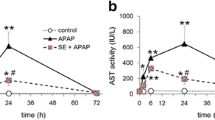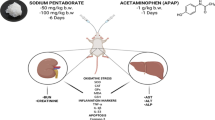Abstract
From a disease-prevention perspective, recent progress in phytochemical and nutraceutical research clearly suggests (benefits outweigh the risk pattern). Although powerful antioxidant properties have been the most acclaimed mechanism of action for these entities, the individual antioxidants studied in clinical trials do not appear to have consistent preventative effects. The actions of the antioxidant nutrients alone do not explain the observed health benefits of diets rich in fruits and vegetables for chronic diseases. Therefore, we proposed that the additive and synergistic effects of phytochemicals in fruits and vegetables are responsible for these potent antioxidant and anticancer activities, and that the benefit of a diet rich in fruits and vegetables is attributed to the complex mixture of phytochemicals present in plants [1]. Surprisingly, however, no studies have attempted to evaluate the combined antitoxic potential of a phytochemical-nutraceutical mixture (PNM) in in vivo models. Therefore, this study, for the first time, was designed to investigate whether pre-exposure to a unique PNM has the ability to impede mechanistic events involved in acetaminophen (APAP)-induced hepatotoxicity. Besides several vitamins and minerals in balanced proportions (~US RDA), the PNM used in this investigation contained several well-known phytochemicals such as citrus flavonoids, red wine polyphenols, Garcinia, Gymnema, Ginkgo, Ephedra sinica, Camelia sinensis, Silybum, Guarana, Eluthero, Allium sativum and Ocimum basilicum extracts. To evaluate PNM's antitoxic potential, groups of animals ICR mice, 3 months old) received either a control diet or PNM containing diets (1X and 10X) for 4 weeks. On day-28, animals were divided into two subgroups. Half the animals were administered normal saline and the other half received 400mg/kg ip injections of APAP. All the animals were sacrificed 24h after APAP exposure. Serum and tissue (liver and kidneys) samples were analyzed. APAP alone caused massive liver injury (nearly 495-fold increase in ALT) and oxidative stress (Lipid peroxidation: 268% increase in MDA) coupled with genomic DNA fragmentation (288% increase). Exposure to 1X-PNM for 28 days significantly reduced animal mortality and all the APAP-induced biochemical events (In 1X-PNM + AP: ALT leakage decreased to 54 fold; MDA accumulation decreased to 125%, and DNA fragmentation decreased to 122%), whereas 10X-PNM + APAP slightly escalated both oxidative stress and genomic DNA fragmentation preceding liver injury. Liver homogenates subjected to western blot analysis disclosed the ability of 1X-PNM to counteract APAP-induced decrease in Bcl-xL expression. Histopathological evaluation of stained liver tissue sections indicated anti-apoptogenic and anti-necrogenic reponses coupled with near complete prevention of glycogen depletion by 1X-PNM. Collectively, our investigation suggests that a mixture containing an assortment of phytochemicals/nutraceuticals may serve as a much more powerful blend in preventing drug or chemical-induced organ injuries than a single phytochemical or nutraceutical entity. In addition, ephedra and caffeine containing PNM-exposure in a controlled manner may potentially shield vital target organs from toxicities caused by intentional, unintentional or accidental exposures to structurally and functionally diverse drug and chemical entities.
Similar content being viewed by others
References
Ray SD, Lam TS, Rotollo JA, Phadke S, Patel C, Stohs, SJ: Oxidative stress is the master operator of drug and chemically-induced programmed and unprogrammed cell death: Implications of natural antioxidants in vivo. Biofactors 21(1-4): 223–232, 2004
Lee KW, Lee KJ, Lee CY: Vitamins, phytochemicals, diets, and their implementation in cancer chemoprevention. Crit Rev Food Sci Nutr 44: 437–452, 2004
Lampe JW: Spicing up a vegetarian diet: chemopreventive effects of phytochemicals. Am J Clin Nutr 78(3 Suppl): 579S&583S, 2003
Lampe JW: Nutrition and cancer prevention: small-scale human studies for the 21st century. Cancer Epidemiol Biomarkers Prev 13: 1987–1988, 2004
Graf BA, Milbury PE, Blumberg JF: Flavonols, flavones, flavanones, and human health: epidemiological evidence. J Med Food 8(3): 281–290, 2005
Ray S, Phadke S, Patel C, Hackman RM, Stohs, S: Short-term and long-term in vivo exposure to an ephedra- and caffeine-containing metabolic nutrition system does not induce cardiotoxicity in B6C3F1 mice. Arch Toxicol 79: 330–340, 2005
Ray SD, Zinkovsky D, Bulku E, Patil BS: Prevention of drug-induced programmed and unprogrammed cell death by citrus flavonoids. ACS Symposium series; AGFD Section entitled “Potential health benefits of Citrus”, American Chemical Society Publications, Ed. Patil, B. S. 2006b (In Press).
Ray SD, Kumar MA, Bagchi D: A novel proanthocyanidin IH636 grape seed extract increases in vivo Bcl-XL expression and prevents acetaminophen-induced programmed and unprogrammed cell death in mouse liver. Arch Biochem Biophys 369(1): 42–58, 1999
Surh YJ: Cancer chemoprevention with dietary phytochemicals. Nat Rev Cancer 3(10): 768–80, 2003
Dorai T, Aggarwal BB: Role of chemopreventive agents in cancer therapy. Cancer Lett 215(2): 129–140, 2004
Watanabe S, Zhuo XG, Kimira M: Food safety and epidemiology: new database of functional food factors. Biofactors 22(1-4): 213–219, 2004
Wroblewski F, Ladue JS: Serum glutamic pyruvic transaminase in cardiac with hepatic disease. Proc Soc Exp Biol Med 91(4): 569–571, 1956
Ray SD, Mumaw VR, Raje RR, Fariss MW: Protection of acetaminophen-induced hepatocellular apoptosis and necrosis by cholesteryl hemisuccinate pretreatment. J Pharmacol Exp Ther 279(3): 1470–1483, 1996
Ray SD, Balasubramanian G, Bagchi D, Reddy CS: Ca(2+)-calmodulin antagonist chlorpromazine and poly(ADP-ribose) polymerase modulators 4-aminobenzamide and nicotinamide influence hepatic expression of BCL-XL and P53 and protect against acetaminophen-induced programmed and unprogrammed cell death in mice. Free Radic Biol Med 31(3): 277–291, 2001
Ray SD: Oxidative stress orchestrates both apoptosis and necrosis in vivo: a new perspective from molecular toxicology. Proc. Of the Meeting of the Soc. Free Rad. Res. (European Section); Free Radicals and Oxidative stress: Chemistry, Biochemistry and Pathophysiological Implications, In: Galaris, D.; ed., Medimond S.r.l., Monduzzi Editore Int. Proc. Div., Italy, pp. 45–53, 2003
Ray SD, Kamendulis LM, Gurule MW, Yorkin RD, Corcoran GB: Ca2+ antagonists inhibit DNA fragmentation and toxic cell death induced by acetaminophen. FASEB J 7(5): 453–463, 1993
Burton K: A study of the conditions and mechanism of the diphenylamine reaction for the colorimetric estimation of deoxyribonucleic acid. Biochem J 62(2): 315–323, 1956
Ray SD, Jena N: A hepatotoxic dose of acetaminophen modulates expression of BCL-2, BCL-X(L), and BCL-X(S) during apoptotic and necrotic death of mouse liver cells in vivo. Arch Toxicol 73(10-11): 594–606, 2000
Ray SD: Cell Death and apoptosis, Vol 1, Chapter 9, In: General & Applied Toxicology, Ballantyne, B.; Marrs, T.; Turner, P. eds.; Nature Publishing (McMillan), London, Pp. 175–213, 1999
Liu J, Li C, Waalkes MP, Clark J, Myers P, Saavedra JE, Keefer LK: The nitric oxide donor, V-PYRRO/NO, protects against acetaminophen-induced hepatotoxicity in mice. Hepatology 37(2): 324–333, 2003
Ray SD, Bagchi D: Roles of Polyphenoles, Flavonoids and Oligomeric Proanthocyanidins in Cancer Chemoprevention, Chapter 21, In: Bagchi, D. and Preuss, H. G. Eds., CRC Press, Boca Raton, FL, Pp. 311–348, 2004
Moskaug JO, Carlsen H, Myhrstad MC, Blomhoff R: Polyphenols and glutathione synthesis regulation. Am J Clin Nutr 81(1 Suppl): 277S&283S, 2005
Hinson JA, Reid AB, McCullough SS, James LP: Acetaminophen-induced hepatotoxicity: role of metabolic activation, reactive oxygen/nitrogen species, and mitochondrial permeability transition. Drug Metab Rev 36(3-4): 805–822, 2004
Dhruva, D.; Ray, S. D. Role of nitric oxide in acetaminophen-induced apoptosis and necrosis and its modulation by 3-aminobenzamide. J Toxicol Clin Toxicol 34: 575, 1996
Ray, S. D.; Parikh, H.; Bagchi, D. Proanthocyanidin exposure to B6C3F1 mice significantly attenuates dimethylnitrosamine-induced liver tumor induction and mortality by differentially modulating programmed and unprogrammed cell deaths. Mutation Res 579(1-2): 81–106, 2005
Blazka ME, Wilmer JL, Holladay SD, Wilson RE, Luster MI: Role of proinflammatory cytokines in acetaminophen hepatotoxicity. Toxicol Appl Pharmacol 133(1): 43–52, 1995
Gardner CR, Laskin JD, Dubach DM, Sacco M, Durham SK, Bruno MK, et al. Reduced hepatotoxicity of acetaminophen in mice lacking inducible nitric oxide synthase: potential role of tumor necrosis factor-alpha and interleukin-10. Toxicol Appl Pharmacol 184(1): 27–36, 2002
James LP, Makeup PR, Hinson JA: Acetaminophen-induced hepatotoxicity. Drug Metab Dispos 31(12): 1499–506, 2003
Zhang H, Cook J, Nickel J, Yu R, Stecker K, Myers K, Dean NM: Reduction of liver Fas expression by an antisense oligonucleotide protects mice from fulminant hepatitis. Nat Biotechnol 18(8): 862–867, 2000
Ishida Y, Kondo T, Ohshima T, Fujiwara H, Iwakura Y, Mukaida N: A pivotal involvement of IFN-gamma in the pathogenesis of acetaminophen-induced acute liver injury. FASEB J 16(10): 1227–1236, 2002
Fiorucci S, Antonelli E, Mencarelli A, Palazzetti B, Alvarez-Miller L, Muscara M, del Soldato P, Sanpaolo L, Wallace JL, Morelli A: A NO-releasing derivative of acetaminophen spares the liver by acting at several checkpoints in the Fas pathway. Br J Pharmacol 135(3): 589–599, 2002
Ferret PJ, Hammoud R, Tulliez M, Tran A, Trebeden H, Jaffray P, Malassagne B, Calmus Y, Weill B, Batteux F: Detoxification of reactive oxygen species by a nonpeptidyl mimic of superoxide dismutase cures acetaminophen-induced acute liver failure in the mouse. Hepatology 33(5): 1173–180, 2001
Esterline RL, Ray SD, Ji S: Reversible and irreversible inhibition of hepatic mitochondrial respiration by acetaminophen and its toxic metabolite, N-acetyl-p-benzoquinoneimine (NAPQI). Biochem Pharmacol 38(14): 2387–2390, 1989
Ramsay RR, Rashed MS, Nelson SD: In vitro effects of acetaminophen metabolites and analogs on the respiration of mouse liver mitochondria. Arch Biochem Biophys 273(2): 449–457, 1989
Burcham PC, Harman AW: Acetaminophen toxicity results in site-specific mitochondrial damage in isolated mouse hepatocytes. J Biol Chem 266(8): 5049–5054, 1991
Jaeschke H, Bajt ML: Intracellular Signaling Mechanisms of Acetaminophen-Induced Liver Cell Death. Toxicol Sci 89(1): 31–41, 2005
Gottlieb, E.; Vander Heiden, M. G.; Thompson, C. B. Bcl-xL Prevents the Initial Decrease in Mitochondrial Membrane Potential and Subsequent Reactive Oxygen Species Production during Tumor Necrosis Factor Alpha-Induced Apoptosis. Mol Cell Biol. 20(15): 5680–5689; 2000.
Napirei M, Basnakian AG, Apostolov EO, Mannherz HG. Deoxyribonuclease 1 aggravates acetaminophen-induced liver necrosis in male CD-1 mice. Hepatology 43(2): 297–305, 2006
Mirkovic N, Voehringer DW, Story MD, McConkey DJ, McDonnell TJ, Meyn RE: Resistance to radiation-induced apoptosis in Bcl-2-expressing cells is reversed by depleting cellular thiols. Oncogene 15: 1461–1470, 1997
Tyurina YT, Tyurin VA, Carta G, Quinn PJ, Schor NF, Kagan VE: Direct evidence for antioxidant effect of Bcl-2 in PC12 rat pheochromocytoma cells. Arch Biochem Biophys 344: 413–423, 1997
Molnar D, Torok K, Erhardt E, Jeges S: Safety and efficacy of treatment with an ephedrine/caffeine mixture. The first double-blind placebo-controlled pilot study in adolescents. Int J Obes Relat Metab Disord 24: 1573–1578, 2000
Haller CA, Jacob P III., Benowitz NL: Pharmacology of ephedra alkaloids and caffeine after single-dose dietary supplement use. Clin Pharmacol Ther 71: 421–432, 2002
Morgenstern LB, Viscoli CM, Kernan WN: Use of Ephedra containing products and risk for hemorrhagic stroke. Neurology 60: 132–135, 2003
Shekelle PG, Hardy ML, Morton SC: Efficacy and safety of ephedra and ephedrine for weight loss and athletic performance: a meta-analysis. JAMA 289: 1537–1545, 2003
CRN. The CANTOX report on ephedra. Council for Responsible Nutrition, Washington DC; 2002 (see http://www.crnusa.org/cantoxoverview.html).
Author information
Authors and Affiliations
Corresponding author
Rights and permissions
About this article
Cite this article
Ray, S.D., Patel, N., Shah, N. et al. Pre-exposure to a novel nutritional mixture containing a series of phytochemicals prevents acetaminophen-induced programmed and unprogrammed cell deaths by enhancing BCL-XL expression and minimizing oxidative stress in the liver. Mol Cell Biochem 293, 119–136 (2006). https://doi.org/10.1007/s11010-006-9235-2
Received:
Accepted:
Published:
Issue Date:
DOI: https://doi.org/10.1007/s11010-006-9235-2




